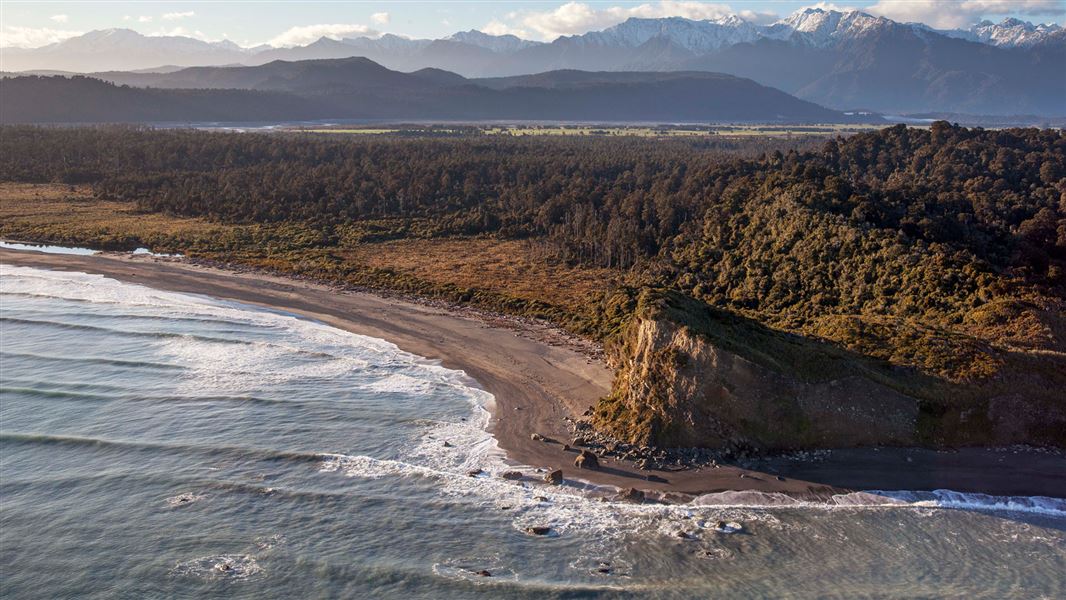The marine reserve was established in 2014 and is 4557 hectares.
There are plenty of walks and tracks to explore in the Ōkārito area, including the Ōkārito Lagoon Kayak Trail.
The marine reserve lies alongside parts of Westland Tai Poutini National Park and Te Wāhipounamu South West New Zealand World Heritage Area.
Access is best by Three Mile Pack Track - Ōkārito Coastal Walk from Ōkārito. It's about a one hour walk each way.
Bikes or other forms of transportation are not permitted on the track.
Be prepared
Extreme rainfall events are reasonably common here. Visitors should be well prepared with food, water, warm clothing and wet weather gear. You should tell a responsible person where you are going and how long you expect to be away.
You should be aware of possible hazards such as waves on the beach and swift currents in the rivers and lagoon mouths.
Quad bikes and horses
Riding of quad bikes and horses is allowed within the reserve, providing there is minimal disturbance to the site and riders comply with legal requirements. It's a marine
Collecting and pounamu
Stones (less than 256 mm in diameter), shells, driftwood, and gravel can be collected by hand recreationally, but only as much as you can carry in one trip and with minimal disturbance to the site.
Pounamu can also be collected but only by members of Ngāi Tahu Whanui, or with the permission of Te Rūnanga o Ngāi Tahu.
The reserve extends nearly 11 km south from Kohuamarua Bluff – near Ōkārito – to Omoeroa Bluff, and about 4 km out to sea.
Moraine debris from the glaciers has created distinctive lumpy headlands along the reserve. Over thousands of years gravel and sand have been swept north by the Westland Current, creating a buffer zone against ferocious seas.
Calm wetlands and lagoons have formed within this zone, creating an abundant and distinctive habitat. The reserve itself protects 46 square km of coastal sea beyond these wetland systems, and a short distance up the Waiho River.
Boulder reefs support fish, invertebrates and seaweed which are typical of the mid West Coast, giving way to a sandy seafloor.

The beaches are gravelly and the seabed muddy - a result of runoff from the Waiho River and other waterways in this area, which are constantly fed by glacial flow through thick rainforest. Extreme rainfall events are reasonably common here.
Report illegal or suspicious activity
Don't take, disturb, kill or damage anything within the reserve - it's illegal. If you see people taking anything from the reserve, report the activity as soon as possible.
You can call 0800 4 POACHER (0800 476 224) or 0800 DOCHOT (0800 362 468).
It is also an offence to pollute or litter the reserve, discharge any firearm in or into the reserve or erect any structure in the reserve.
Reporting pests
Find-A-Pest lets you report potential pest species, including marine, plant, animal and fungal species.
If you come across something out of the ordinary, upload a picture to the app and a specialist will help identify it. If it's a biosecurity threat, this will be forwarded to Biosecurity New Zealand. If possible, take photos and record the location and name of the vessel.
Or call the Ministry for Primary Industries' Pest and Diseases hotline on 0800 80 99 66.
Waiau Glacier Coast Marine Reserve is named because it is close to Franz Josef and other glaciers, which are just 30 km from the coast. “Waiau” is an alternative spelling for the Waiho River.
“The contrast between the ever restless sea – the gigantic waves coming and going without intermission – and the quiet watershed of Lake Ōkārit[o], with its numerous islands, surrounded by luxuriant forest, was most striking.” – Dr Julius Haast, 1865
Protect our marine reserves
- No fishing of any kind.
- Don't take or kill marine life.
- Don't remove or disturb any marine life or materials.
- Don't feed fish - it disturbs their natural behaviour.
- Take care when anchoring to avoid damaging the sea floor.
 No dogs allowed
No dogs allowed
To protect our native wildlife, dogs are not allowed anywhere in this place.
Westland Tai Poutini National Park Visitor Centre
| Phone: | +64 3 752 0360 |
| Email: | westlandnpvc@doc.govt.nz |
| Address: | 69 Cron Street Franz Josef Glacier 7856 |
| Hours: | Visitor centre hours and services |
